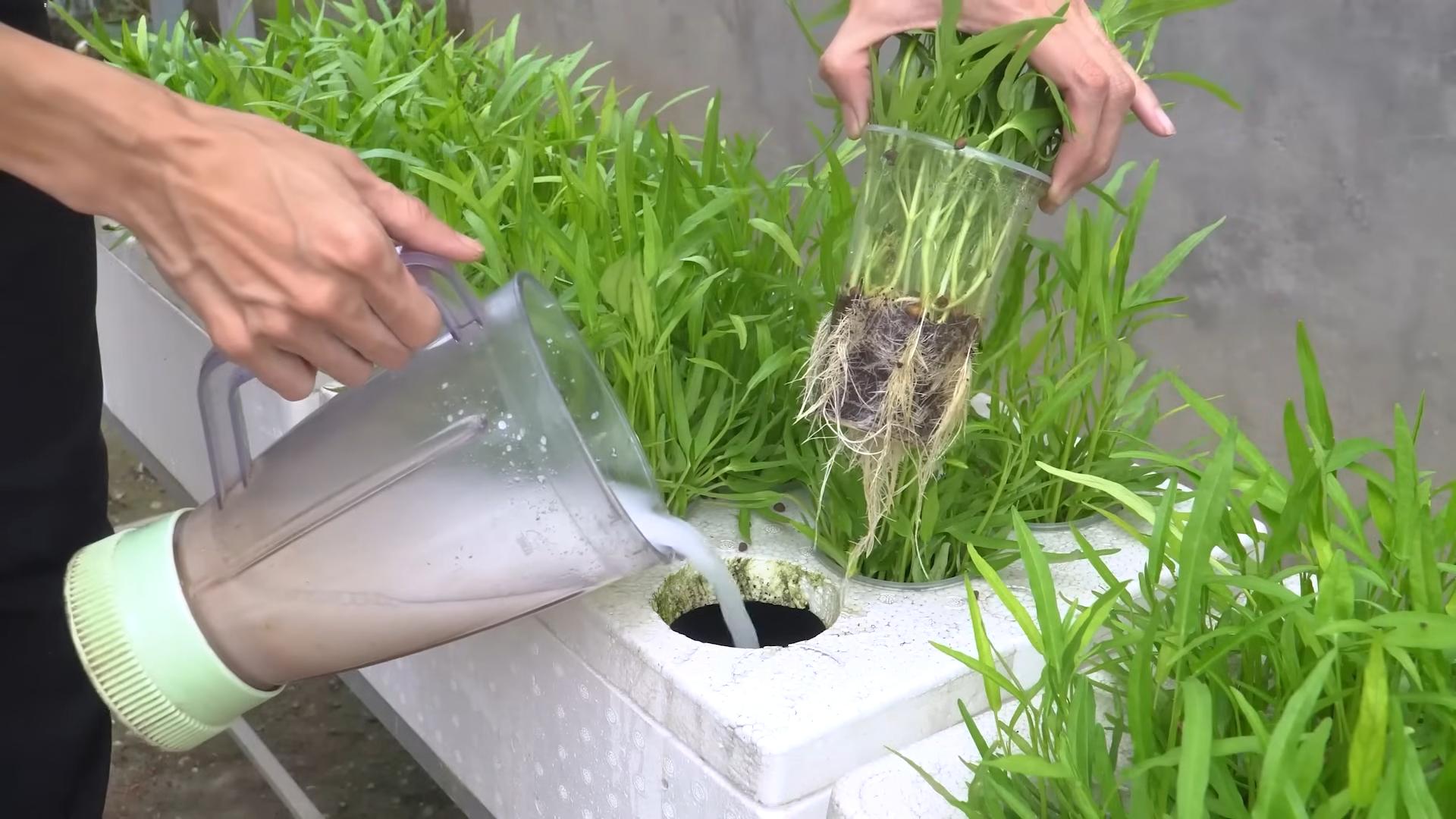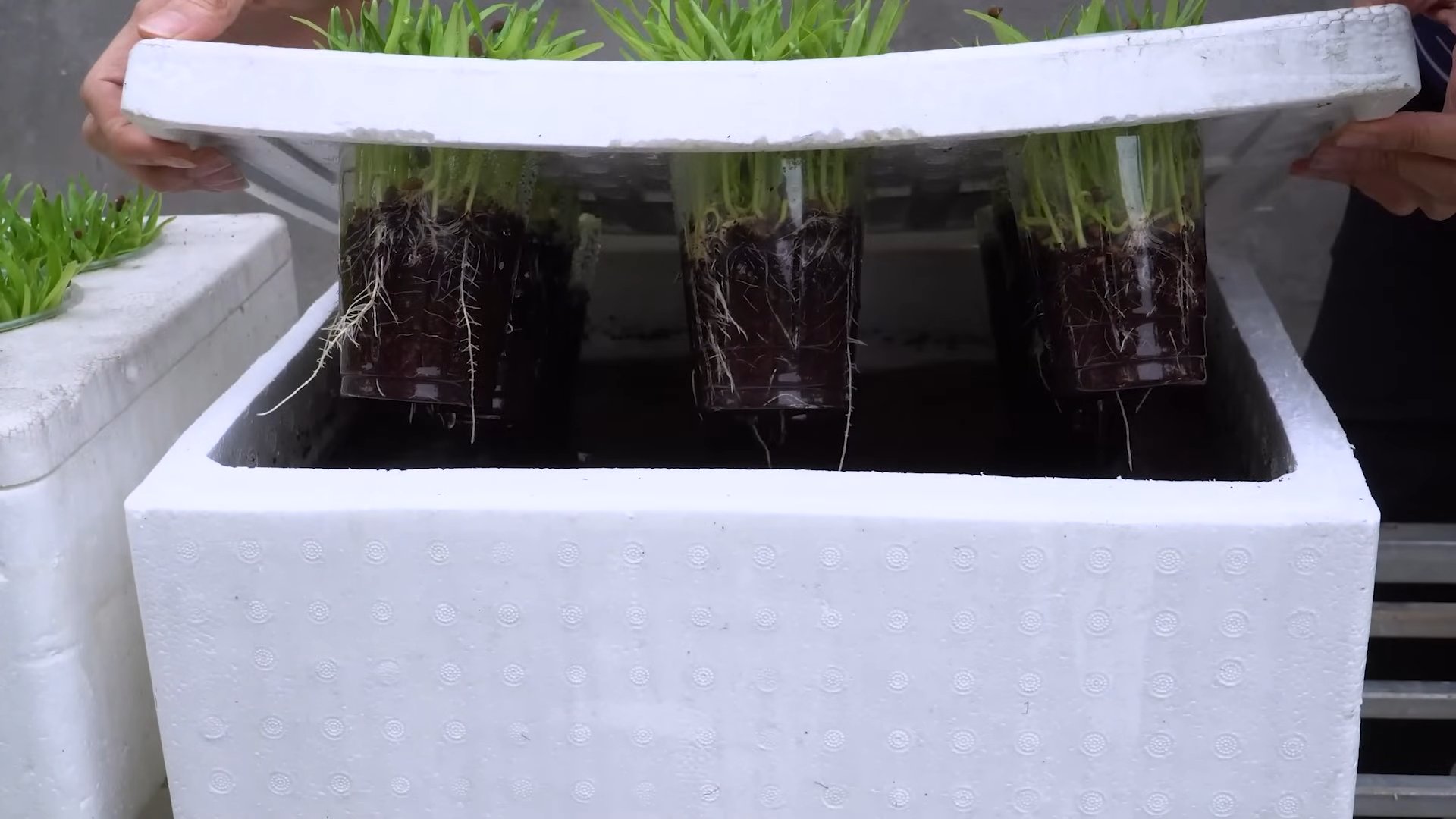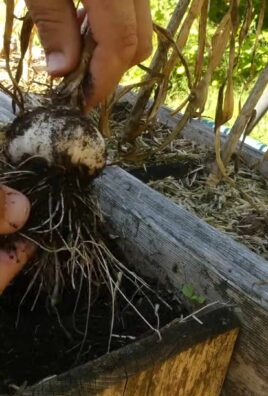Growing water spinach at home can seem daunting, but trust me, it’s easier than you think! Have you ever dreamt of snipping fresh, vibrant greens right from your own backyard to add to your stir-fries or salads? Imagine the satisfaction of knowing exactly where your food comes from and that it’s free from harmful chemicals. That’s the magic of home gardening, and water spinach, also known as Ong Choy, is a fantastic place to start.
Water spinach has a rich history, deeply rooted in Asian cuisine and culture. For centuries, it has been a staple in dishes across Southeast Asia, prized for its delicious flavor and nutritional benefits. Beyond its culinary appeal, it’s also incredibly easy to cultivate, making it perfect for beginner gardeners like you and me.
In today’s world, where we’re increasingly conscious of healthy eating and sustainable living, growing water spinach at home offers a simple yet powerful way to connect with nature and nourish our bodies. Plus, with rising grocery prices, wouldn’t it be amazing to have a readily available supply of this nutritious vegetable right at your fingertips? This DIY guide will equip you with all the essential tricks and hacks to successfully grow water spinach in your own home garden, regardless of your experience level. Let’s get started!

Growing Water Spinach (Kangkong) at Home: A Beginner’s Guide
Hey there, fellow gardening enthusiasts! Ever wanted to grow your own fresh, delicious water spinach (also known as kangkong or ong choy) right in your backyard or even on your balcony? Well, you’re in the right place! I’m going to walk you through the entire process, step-by-step, so you can enjoy this nutritious and versatile leafy green whenever you want. Trust me, it’s easier than you think!
What You’ll Need
Before we dive in, let’s gather all the necessary supplies. Having everything ready beforehand will make the whole process much smoother.
* Water Spinach Seeds or Cuttings: You can find seeds at most garden centers or online. Cuttings are also a great option if you know someone who already grows water spinach.
* Container or Garden Bed: A large pot (at least 12 inches deep and wide), a plastic tub, or a dedicated garden bed will work perfectly.
* Potting Mix or Soil: Use a good quality potting mix if you’re growing in containers. If you’re using a garden bed, make sure the soil is well-draining and rich in organic matter.
* Water: Obviously! Water spinach loves water, so make sure you have a reliable water source.
* Fertilizer (Optional): A balanced liquid fertilizer can help boost growth, but it’s not strictly necessary.
* Sunlight: Water spinach needs at least 6 hours of sunlight per day.
* Gardening Gloves: To keep your hands clean and protected.
* Trowel or Small Shovel: For planting and transplanting.
* Watering Can or Hose: For watering your plants.
Starting from Seeds: A Detailed Guide
If you’re starting from seeds, here’s how to do it:
1. Soaking the Seeds: This is a crucial step to improve germination rates. Place the water spinach seeds in a bowl of lukewarm water and let them soak for 12-24 hours. This will soften the seed coat and help them sprout faster. I usually do this overnight.
2. Preparing the Container or Garden Bed: Fill your chosen container or garden bed with potting mix or soil. Make sure the soil is loose and well-draining. If you’re using a garden bed, you might want to amend the soil with compost or other organic matter to improve its fertility.
3. Sowing the Seeds: Sow the soaked seeds about 1/2 inch deep and 1-2 inches apart. You can sow them in rows or scatter them evenly across the surface. Gently cover the seeds with soil and lightly pat it down.
4. Watering: Water the soil thoroughly after sowing the seeds. Keep the soil consistently moist, but not waterlogged. I like to use a spray bottle to avoid disturbing the seeds.
5. Germination: Water spinach seeds typically germinate within 5-10 days. Keep the soil moist and provide plenty of sunlight. Once the seedlings emerge, you can thin them out if they’re too crowded, leaving about 4-6 inches between plants.
Starting from Cuttings: A Quick and Easy Method
If you have access to water spinach cuttings, this is a faster and easier way to get started:
1. Selecting Cuttings: Choose healthy, mature stems that are about 6-8 inches long. Make sure the cuttings have several nodes (the points where leaves grow).
2. Preparing the Cuttings: Remove the leaves from the bottom 2-3 inches of the cuttings. This will encourage root growth.
3. Rooting the Cuttings (Two Options):
* Water Rooting: Place the cuttings in a glass or jar of water, making sure the bottom nodes are submerged. Change the water every 1-2 days. Roots should start to appear within a week or two.
* Direct Planting: You can also plant the cuttings directly into the soil. Dip the cut ends in rooting hormone (optional) and insert them into the prepared soil, burying the bottom 2-3 inches.
4. Planting the Rooted Cuttings: If you rooted the cuttings in water, gently transplant them into your container or garden bed once the roots are about 1-2 inches long. Space the cuttings about 4-6 inches apart.
5. Watering: Water the newly planted cuttings thoroughly. Keep the soil consistently moist, but not waterlogged.
Caring for Your Water Spinach Plants
Once your water spinach plants are established, here’s how to keep them thriving:
1. Sunlight: Water spinach needs at least 6 hours of sunlight per day. If you’re growing indoors, place your plants near a sunny window or use grow lights.
2. Watering: Water spinach loves water, so keep the soil consistently moist. Water deeply whenever the top inch of soil feels dry to the touch. During hot weather, you may need to water daily.
3. Fertilizing (Optional): If you want to boost growth, you can fertilize your water spinach plants every 2-3 weeks with a balanced liquid fertilizer. Follow the instructions on the fertilizer package. I personally like using a diluted seaweed extract.
4. Pruning: Regular pruning encourages bushier growth and prevents the plants from becoming leggy. Pinch off the tips of the stems to promote branching.
5. Pest and Disease Control: Water spinach is generally pest-resistant, but keep an eye out for aphids, spider mites, and snails. You can control these pests with insecticidal soap or by handpicking them off the plants. Avoid overhead watering to prevent fungal diseases.
Harvesting Your Water Spinach
The best part! You can start harvesting your water spinach about 4-6 weeks after planting.
1. When to Harvest: Harvest when the stems are about 6-8 inches long.
2. How to Harvest: Use scissors or a sharp knife to cut the stems about 2-3 inches above the soil line. This will allow the plants to regrow and produce more leaves.
3. Successive Harvesting: You can harvest water spinach multiple times from the same plant. Just keep watering and fertilizing as needed.
4. Enjoying Your Harvest: Water spinach is delicious in stir-fries, soups, salads, and other dishes. It’s also a great source of vitamins and minerals.
Troubleshooting
Even with the best care, you might encounter some problems. Here are a few common issues and how to address them:
* Yellowing Leaves: This could be a sign of overwatering, underwatering, or nutrient deficiency. Check the soil moisture and adjust your watering accordingly. If the soil is consistently moist, it could be a sign of root rot. Make sure your container has good drainage. If you suspect nutrient deficiency, try fertilizing with a balanced fertilizer.
* Slow Growth: This could be due to insufficient sunlight, poor soil, or lack of nutrients. Make sure your plants are getting enough sunlight and that the soil is fertile. Fertilize regularly if needed.
* Pests: As mentioned earlier, aphids, spider mites, and snails can sometimes be a problem. Use insecticidal soap or handpick them off the plants.
Tips for Success
Here are a few extra tips to help you grow the best water spinach possible:
* Choose the Right Variety: There are different varieties of water spinach available, so choose one that is well-suited to your climate.
* Provide Support: Water spinach can grow quite tall, so you may want to provide some support, such as a trellis or stakes.
* Keep the Soil Moist: Water spinach thrives in moist conditions, so don’t let the soil dry out.
* Harvest Regularly: Regular harvesting encourages bushier growth and prevents the plants from becoming leggy.
* Don’t Be Afraid to Experiment: Gardening is all about learning and experimenting. Don’t be afraid to try different techniques and see what works best for you.
Growing Water Spinach in Water (Hydroponically)
Did you know you can also grow water spinach directly in water, hydroponically? It’s a fun and easy way to grow this vegetable without any soil!
1. Prepare Your Container: Choose a container that can hold water, like a bucket or a large tub.
2. Secure the Cuttings: You’ll need a way to hold the water spinach cuttings in place so that their roots are submerged in water but the stems remain above the water line. You can use a piece of styrofoam with holes cut in it, or a net pot suspended over the water.
3. Add Water and Nutrients: Fill the container with water and add a hydroponic nutrient solution according to the manufacturer’s instructions. This will provide the plants with the nutrients they need to grow.
4. Place the Cuttings

Conclusion
So, there you have it! Growing water spinach at home is not only surprisingly simple, but it’s also incredibly rewarding. Imagine stepping out to your own backyard or balcony and harvesting fresh, crisp, and vibrant water spinach whenever you need it. Forget those wilted, overpriced bunches at the grocery store – with this easy DIY trick, you’ll have a constant supply of this nutritious and delicious leafy green right at your fingertips.
This method is a must-try for several reasons. First, it’s incredibly cost-effective. Once you have your initial seeds or cuttings, you can essentially propagate water spinach indefinitely, saving you money on groceries in the long run. Second, it’s environmentally friendly. You’re reducing your carbon footprint by growing your own food and avoiding the transportation and packaging associated with store-bought produce. Third, it’s incredibly satisfying. There’s nothing quite like the feeling of nurturing a plant from seed to harvest and then enjoying the fruits (or, in this case, the leaves) of your labor.
But the best part? This DIY trick is incredibly versatile. You can grow water spinach in a variety of containers, from small pots to large tubs, making it suitable for even the smallest of spaces. You can also experiment with different growing mediums, such as soil, water, or a combination of both. For those looking for a more advanced setup, consider incorporating a simple hydroponic system for even faster growth and higher yields.
Want to add a little extra flavor to your homegrown water spinach? Try adding a diluted seaweed fertilizer to the water every few weeks. This will not only boost growth but also enhance the flavor of the leaves. You can also experiment with different varieties of water spinach, such as the green-stemmed or white-stemmed types, each offering a slightly different texture and taste.
We’ve covered the basics, but don’t be afraid to get creative and adapt this DIY trick to suit your own needs and preferences. The possibilities are endless!
Now, it’s your turn. We wholeheartedly encourage you to give this DIY trick a try and experience the joy of growing your own water spinach at home. It’s easier than you think, and the rewards are well worth the effort. Once you’ve harvested your first batch, be sure to share your experience with us in the comments below. We’d love to hear about your successes, your challenges, and any tips or tricks you’ve discovered along the way. Let’s build a community of home gardeners and share the love of fresh, homegrown water spinach! So go ahead, embrace your inner gardener and start growing your own delicious and nutritious water spinach today! You won’t regret it.
Frequently Asked Questions (FAQ)
What exactly is water spinach, and why should I grow it?
Water spinach, also known as ong choy or kangkong, is a semi-aquatic leafy green vegetable popular in Southeast Asian cuisine. It’s known for its mild, slightly sweet flavor and crisp texture. Growing it yourself offers several advantages: it’s fresher than store-bought, often cheaper, and allows you to control the growing conditions, ensuring it’s free from harmful pesticides. Plus, it’s a fast-growing plant, so you’ll be harvesting in no time!
How do I get started with growing water spinach at home?
You can start water spinach from seeds or cuttings. Seeds are readily available online or at Asian grocery stores. Cuttings can be taken from mature water spinach plants. To start from seeds, soak them in water for 24 hours before planting them in a pot or container filled with moist soil. To start from cuttings, simply place the cut end of the stem in water until roots develop, then transplant it into soil or a water-based growing system.
What kind of container should I use to grow water spinach?
Water spinach can be grown in a variety of containers, depending on your space and preferences. Pots, tubs, buckets, or even repurposed containers like plastic bins can work well. The key is to ensure the container has drainage holes if you’re growing in soil, or that it can hold water if you’re growing hydroponically. A container that is at least 6-8 inches deep is recommended to allow for adequate root growth.
What kind of soil or growing medium is best for water spinach?
Water spinach thrives in moist, nutrient-rich soil. A good potting mix amended with compost or well-rotted manure is ideal. You can also grow water spinach hydroponically, using a water-based nutrient solution. If growing in soil, ensure it drains well to prevent waterlogging.
How much sunlight does water spinach need?
Water spinach needs at least 4-6 hours of direct sunlight per day to thrive. If you don’t have a sunny spot, you can supplement with grow lights. Insufficient sunlight can result in leggy growth and reduced yields.
How often should I water water spinach?
Water spinach loves moisture, so keep the soil consistently moist. Water daily, or even twice a day during hot weather. If growing hydroponically, ensure the water level is maintained and the nutrient solution is replenished regularly.
How long does it take for water spinach to grow?
Water spinach is a fast-growing plant. You can typically start harvesting leaves within 4-6 weeks of planting. Continue harvesting regularly to encourage new growth.
How do I harvest water spinach?
You can harvest water spinach by cutting the stems about 4-6 inches from the base of the plant. This will encourage new shoots to grow. You can also harvest individual leaves as needed.
What are some common problems when growing water spinach, and how can I prevent them?
Some common problems include pests like aphids and spider mites, as well as fungal diseases caused by excessive moisture. To prevent pests, inspect your plants regularly and treat any infestations promptly with insecticidal soap or neem oil. To prevent fungal diseases, ensure good air circulation and avoid overwatering.
Can I grow water spinach indoors?
Yes, you can grow water spinach indoors, but you’ll need to provide adequate light. A sunny windowsill or grow lights are essential for successful indoor growing.
Is water spinach safe to eat?
Yes, water spinach is generally safe to eat. However, it’s important to source your seeds or cuttings from a reputable source to ensure they are free from contaminants. Also, wash the leaves thoroughly before eating to remove any dirt or debris. If growing in water, ensure the water source is clean and free from pollutants.
How do I store harvested water spinach?
Store harvested water spinach in the refrigerator in a plastic bag or container. It will stay fresh for several days.
Can I grow water spinach in cold climates?
Water spinach is a tropical plant and prefers warm temperatures. It is best grown during the warmer months. If you live in a cold climate, you can start your plants indoors and transplant them outdoors when the weather warms up. You can also grow them in a greenhouse or under grow lights to extend the growing season.
What are some ways to cook with water spinach?
Water spinach is a versatile vegetable that can be used in a variety of dishes. It’s commonly stir-fried with garlic and chili, added to soups and stews, or used in salads. It can also be steamed or boiled.
Where can I find more information about growing water spinach?
There are many resources available online and in libraries about growing water spinach. Search for articles, videos, and books on the topic. You can also consult with local gardening experts or join online gardening communities for advice and support.




Leave a Comment